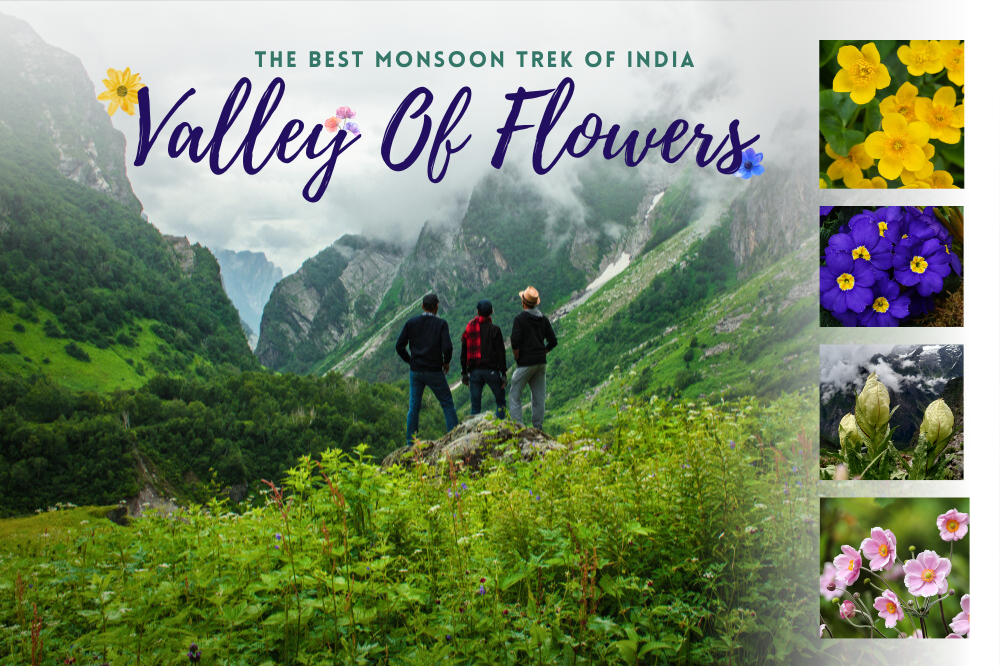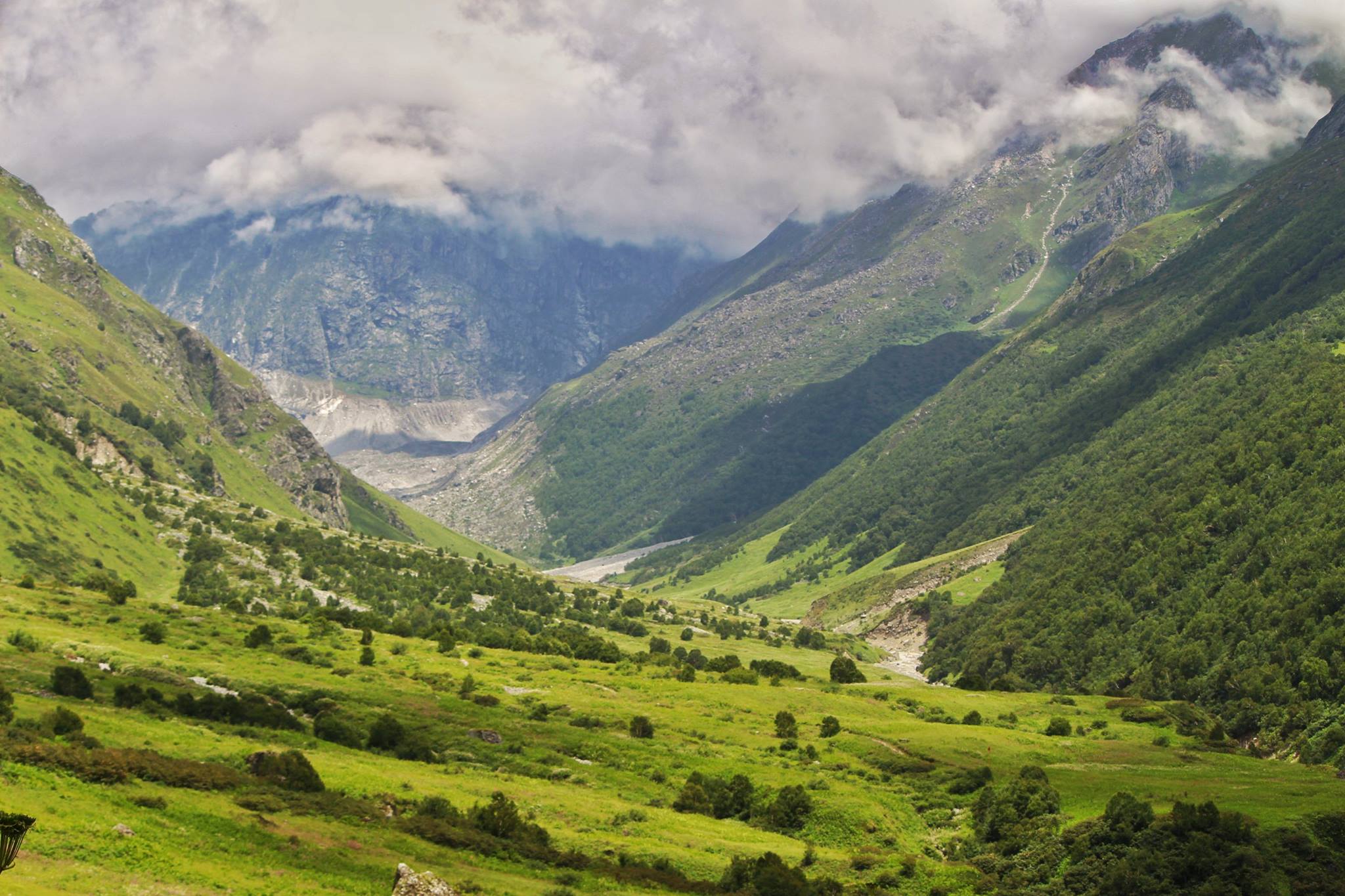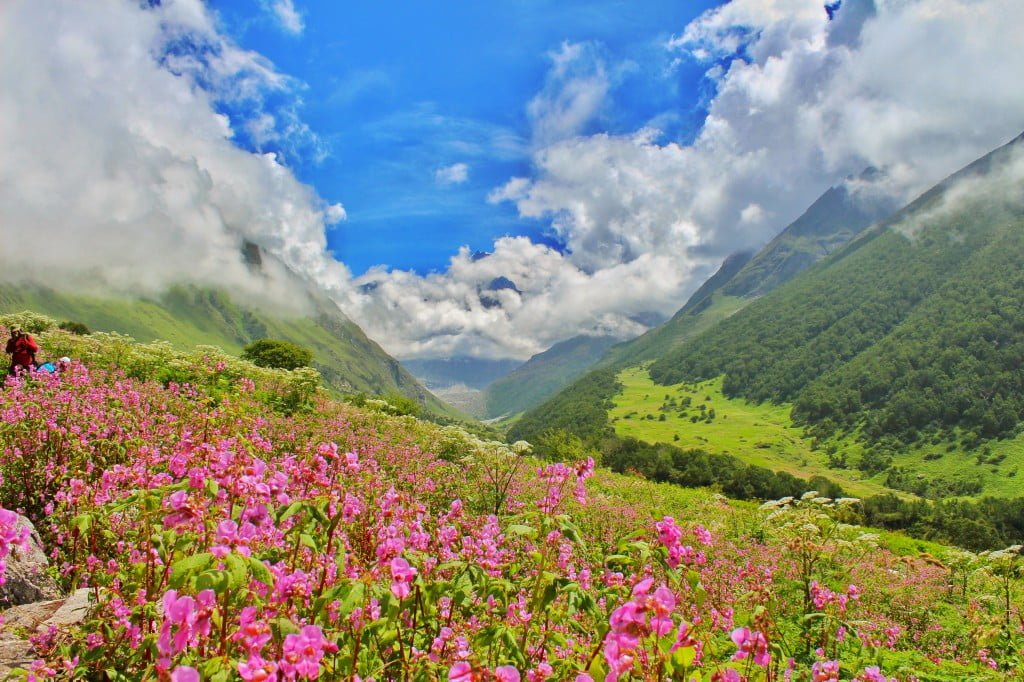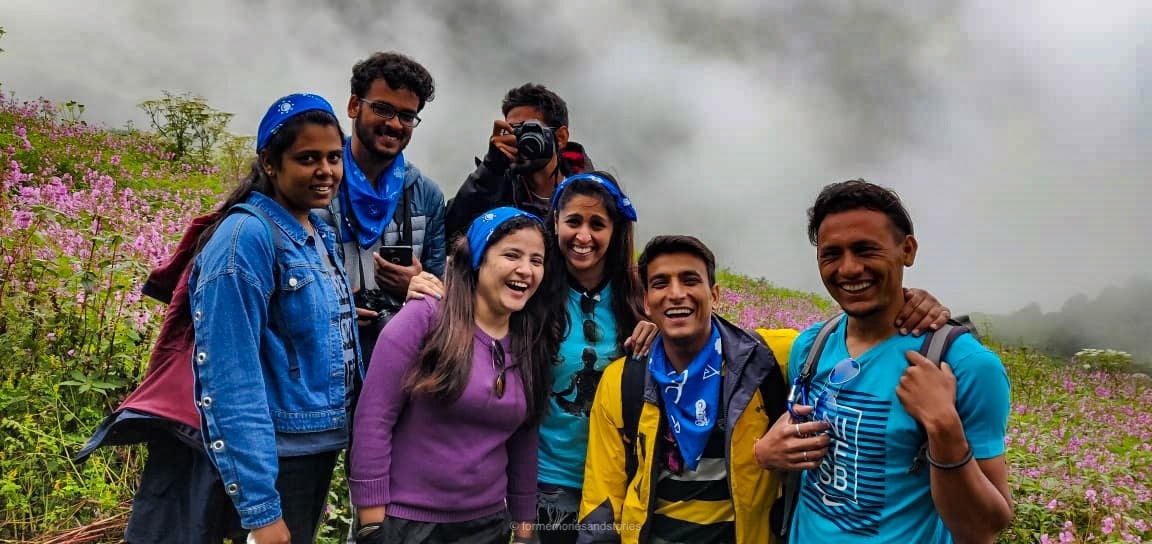Valley of Flowers Trek
Details
Inclusions
Safe Travel
Flexible Cancellation
Easy EMI
Certified Captains
24/7 Support
Overview
The Valley of Flowers Trek is nestled in the vicinity of the Nanda Devi Biosphere Reserve and its multitude of blooming flowers covering the vast expanse of land makes the valley of flowers one of the most beautiful Himalayan treks our country has to offer. Stretched to an expanse of 87.5 square kilometers with an altitude of 14,200 ft, the valley of flowers trek is popular among all kinds of trekkers. The sheer beauty that the rich biodiversity offers attract many avid nature lovers and the steep ascents and descents allow trekkers to relish in the experience of commencing this Himalayan trek and tick it off of their bucket list. With the Hemkund Sahib awaiting on the other side of the trek, many pilgrims embark upon the valley of flowers trek as well. Being one of the oldest known treks, The valley of flower trek came on every trekker's radar all over the world when it was declared a world heritage site by UNESCO in 2002. The valley is home to more than 520 species of flowers that come together to form a tapestry of colors in front of you with dominating shades of pink, blue and purple. The valley of flowers national park is located in the Chamoli district of Uttarakhand and along with being home to a diverse range of flora, it is also home to many endangered animals including snow leopards and red foxes. Nestled at an altitude of approx 12,000ft, The Valley of Flower National park along with Nanda Devi National park come together to form a transition zone between the mighty Himalayas and the Zanskar range of mountains.
The valley of flowers trek comes under the easy to moderate category when it comes to grading the difficulty level and is considered to be a perfect trek for beginners and even a great trek for families. The hardest climb is the one to Hemkund Sahib Gurudwara which is the highest Gurudwara in the world and one of the most important pilgrim sites in Uttarakhand. The valley itself stretches to a length of almost 10 kilometers, with colors of rainbows speckled across the patchwork of grass, compelling you to stop and look at them closely. The scent of flora lingers in the air and is hard to miss as you keep traversing through the valley, walking on the narrow path that cuts across the flower beds to make way.
In this valley of flower trek itinerary, we start our journey with an 8-hour drive from Rishikesh to Joshimath which is the base camp for the Valley of flowers trek. Though the drive can seem strenuous, the beautiful scenery that accompanies you provides you a glimpse at four of the Panch Prayag which are five holy sites of the confluence of the river Ganga namely - Devprayag, Rudraprayag, Karnaprayag, and Nand Prayag will surely this drive a visual treat for your eyes. Upon reaching Joshimath, we will check into our lodgings and retire for the night. The next day, we drive from Joshimath to Pulna village which is the starting point for the valley of flower trek. Upon reaching there, we start trekking to Ghangaria. We gradually ascend on a stretch of a 9-kilometer route with the Pushpawati river flowing alongside. The trek is considered to be of the easy to moderate category with the uphill route consisting of stone-carved paths and steep ascents testing your endurance slightly as you walk up to your next campsite, Ghangaria village which is located at an altitude of 10,000ft. The trail is lined with many small dhabas so you will have plenty of resources to refill your water bottles and get snacks as you move forward. After walking for almost half of the distance, you will be able to see the Hathi Parvat ranges in front of you. From there on the climb is steep and you’ll be required to maintain proper footing until you reach your campsite.
The next day you will be able to traverse through the valley of flowers. But before that, you have to cover at least a stretch of 4 kilometers of land. As you keep walking for at least 10 minutes, you will stumble upon the Laxman waterfall which gushes streams of sparkling water, the sight of which will surely refresh you. After a few minutes, you will reach the forest check post, from where you can buy tickets. The check post signifies your proximity to another marvel of nature in the form of a wooden bridge that is perched upon the Pushpavati river. No sooner after you have crossed the bridge, mountains will start peeking from behind. Every direction that you take will seem like a natural paradise because all colors of the rainbow are now on the ground in the form of blooming flowers. The difficulty level of the valley of flowers trek becomes easier here as you have to walk flatly throughout the valley. Adorning the Himalayan peaks with different hues belonging to native flowers like poppies, Himalayan roses, geraniums, etc. The flowery carpet will end after a 5-kilometer stretch at a glacier but the sight of the majestic Himalayan peaks of Nilgiri Parvat, Bhyundar Khal, Rattan, Gauri Parvat, etc still make the view picturesque with a cold stream of water flowing throughout. Eating and camping in the valley aren’t allowed so you will have to head back to Ghangaria and retire for the night.
The hardest part of the valley of flowers trek commences the next day as you head out for Gurudwara Hemkund Sahib, nestled at an altitude of 14,107 ft, it is the highest Gurudwara in the world. The six-hour-long trek from Ghangaria to Hemkund Sahib is challenging in more than one way, the first one being that in a matter of a few hours, you gain an altitude of 5,000ft and the scenic views are replaced by steep descents making the climb rather strenuous. As you keep walking, you will be able to look over the entire valley of flowers and soon a cascading waterfall will come into view. You’d be able to feel the low oxygen levels as you gradually ascend, and that is your cue to keep drinking water as much as you can. After traversing on stone-paved pathways and stumbling upon melting glaciers, Gurudwara Hemkund Sahib will bless you with the Hemkund lake right by its side, mirroring its pristine beauty. All your efforts will feel worth it once you have a cup of hot piping chai and a mouthful of khichdi that is distributed during the Langar.
As you stroll on the premise, you’d feel a sense of peace that you won’t find anywhere else. The lake, which is formed by the melting glaciers of Hathi Parvat and Saptarishi peaks, reflects the grandeur of the mountain as well. When the skies are crystal clear, you get a view of the Saptarishis peaks beckoning you closer while on the lakeside, rare flowers like the Brahma Kamal add more charm to the beauty of Hemkund lake. On a clear day, you will be able to glimpse at the Himalayan peaks of Nilgiri Parvat, Bhyundar Khal, and Gauri Parvat as well. A temple dedicated to Laxman, Lord Rama’s brother is also situated near the lake and you can pay your respects there as well. You will soon have to descend and the 7-kilometer walk can put a strain on your muscles. The next day is relatively easier as the descent to Pulna village would feel easier than the steep uphill climbing of the previous day. The trail is lined with enough dhabas and snack shops making it even easier to descend and in no time you’d have reached the base from where we’d be driving to Joshimath commencing our valley of flowers trek. Being one of the most well-known treks in the Indian Himalayas, the Valley of Flowers trek is quite safe. It has well-laid trails frequented by pilgrims. However, one needs to be careful on the slippery sections of the trail, especially during the rainy season.
The best time to do the Valley of Flowers trek is in July and August when the blooming of flowers is at its peak. The prominent species of flowers that avid nature lovers find here are Brahmakamal, Blue Poppy, Cobra Lily Anemone, Geranium, Marsh Marigold & Primula. Also, the valley has to offer much more than flowers. There are waterfalls, glaciers, towering mountains, gushing rivers, and quaint villages, not to mention an abundance of peace.
Gallery





Itinerary
Day
Rishikesh to Joshimath/Pipalkoti (253 Kms, 8 Hrs Drive)
Day
Joshimath/Pipalkoti to Pulna (22 Kms, 1 hour Drive) | Trek to Ghangaria (9 Kms, 5 Hrs trek)
Day
Ghangaria to Valley of flowers | Back to Ghangaria (10 Kms, 7 Hrs trek)
Day
Ghangaria to Hemkund Sahib (14 Kms, 9 Hrs) | Back to Ghangaria
Day
Ghangaria to Pulna (9 Kms, 5 Hrs) | Drive to Joshimath/Pipalkoti (22 Kms, 1 hour Drive)
Day
Joshimath/Pipalkoti to Rishikesh (253 Kms, 8 Hrs drive)
Age Limit (Trip Wise)
Weekend
Getaways
18-38
Himalayan
Treks
18-48
Backpacking
Trips
18-40
Biking
Trips
18-45
Customized
Trips
No Limit
Inclusions & Exclusions
| Inclusions | Exclusions |
Accommodation: 2 Nights of Accommodation in a hotel in Joshimath, and 3 Nights of Accommodation in a hotel in Ghangaria on a Triple/Quad Sharing basis as per booking. Transportation: Surface transfer from Rishikesh to Rishikesh by Sumo / Tempo Traveler - Non A/c ( Depends on the number of Participants). Meals: All Veg meals from Day 1st Dinner to Day 6th Morning Tea. Snacks: Morning / Evening Tea / Coffee with light snacks. Trek Leader: Qualified and Experienced Trek leader and support staff. Permits: All necessary fees and permits. Safety Equipment: Basic First Aid kit with Oximeter and Oxygen Cylinder. Guide ratio: 1:10 Others : Cloak Room facility available at base camp for extra luggage. | Meals during transit. Insurance of any kind. Any fees and permits (For Foreigners). Unscheduled delay due to a landslide. Charges for Hot water at Ghangaria (Rs 60 per bucket) Cost Escalation due to “Force Majeure and Evacuation charges”. Anything not mentioned explicitly in the above program. Note: You can apply for travel insurance prior to the trek. Bag offloading cost is Rs 1200 (maximum weight should not be more than 10 kg) |
Cancellation Policy
| Upto 21 days | 20-15 days | 14-8 days | 7-0 days | |
| Batch Shifting | ||||
| Cancellation Charge | Free Cancellation | 25% of the Trip Amount | 50% of the Trip Amount | 100% of the Trip Amount |
| Booking Amount | Refunded in mode of Credit Note | Adjusted in Refund Deduction | Adjusted in Refund Deduction | No Refund |
| Remaining Amount | Full Refund (minus) booking amount | Refund (minus) 25% of the trip amount | Refund (minus) 50% of the trip amount | No Refund |
Credit Note :
The Booking Amount will be credited to your JW Profile which can be accessed by logging in to the website through your Phone Number & OTP. Credit Notes issued have no date of expiry and can be used entirely in any of your future trips.
GST :
Any GST charged on any transaction will not be refunded.
Pending Refund :
Any refund pending on your booking will be credited to the same mode of payment through which you paid in 5-7 working days.
Partial Refund :
Any case in which a partial refund will be issued will be calculated after deducting the Booking Amount and Cancellation Charges depending on the time of Cancellation.
Remaining Amount :
Will be calculated on the amount paid over and above the booking amount.
Bypass Policy :
Any and all Cancellation Policies are superseded by the Emergency Case Cancellation Policy in case of situations such as war, pandemics, force majeure, or similar extraordinary events affecting the tour region.
Payment Policy
| Upto 21 days | 21-15 days | 14-08 days | 07-03 days | |
|---|---|---|---|---|
| Booking Amount | ||||
| 50% Payment | Optional | Compulsory | ||
| 75% Payment | Optional | Optional | Compulsory | |
| 100% Payment | Optional | Optional | Optional | Compulsory |
FAQs
How difficult is Hemkund Sahib Trek?
For the most part, Valley of Flowers Trek is an easy one. However, the particular stretch of the trail that takes you from Ghangharia to Hemkund is what makes this trek fall under the moderate category. You gain an altitude of about 5,000ft in the matter of a few hours and the many steep ascents make it a strenous climb.
Is Camping Allowed in Valley of Flowers?
No, the government has put restrictions on camping at Valley of Flowers.
What Kind of Flowers are there in Valley of Flowers National Park?
Orchids, Poppies, Primulas, Marigold, Daisies, Geranium, Petunia, Sediams, Lilies, Calendula, Zinnia, and several others.
Can we visit Valley of Flowers without Trekking?
Valley of Flowers is accessible via helicopters but there is a limitation to this service. You can use the helicopter services provided in Govindghat which drops you at the helipad at Ghangharia. However, you'll still have to trek to Valley of Flowers from Ghangharia.
Is there network in Hemkund Sahib?
There is no connectivity for any mobile network at Hemkund Sahib.
Is Valley of Flowers open in May?
The Valley of Flowers National Park opens in the second or third week of June. It is not accessible in the month of May.
Can Kids do Valley of Flowers Trek?
Many pilgrims take their children to the Valley of Flowers Trek to reach Hemkund Sahib which is a holy place of worship. Children can do this trek. However, caution is advised and the child undertaking the trek should be at least 14 years old or above. The parents will specially have to keep a close watch for any signs of health risks as the high altitude can cause problems and if the child is not old enough, they might not be able to express any discomfort they might be facing. With proper guidance and precautions, kids can do this trek but there are a few limitations.
Where is Valley of Flowers National Park located?
Valley of Flowers National Park is located in the Chamoli district of Uttarakhand. It is nestled in the vicinity of the Nanda Devi Biosphere Reserve and is a World Heritage Site.
How to reach Valley of Flowers National Park?
Valley of Flowers National Park is situated in the Chamoli district of Uttarakhand. You can reach Valley of Flowers by the following means:
By Air: The nearest airport to Valley of Flowers is Jolly Grant Airport at Dehradun. It is well connected by flights from different states.
By Train: Rishikesh is the nearest railway station. You can reach the station and then book a taxi to reach Joshimath.
By Road: You can drive till Joshimath which is approximately 253 Kilometers from Rishikesh.
Is Valley of Flowers trek Safe?
The Valley of Flowers trek traverses through flat lands and fields of flowers. With only a few inclines, the trek is extremely easy to do and is completely safe as well.
Is July a good time to visit Valley of Flowers National park?
July is one of the best months to visit the Valley of flowers as the weather is pleasant and the flowers bloom beautifully. The chances of rain are low as well which means that you get stunning views of the Himalayan peaks without having to navigate through slippery terrains.
How do I plan a trip to Valley of Flowers?
If you're planning a trip from Delhi, then you can just reach Rishikesh. From there, you'll have to drive to Joshimath which is the basecamp for the Valley of Flowers Trek. You'd require four days to do the entire trek. You can plan the rest of your trip depending on where you're coming from and how many days you've
What Is the Best Time to do the Valley of Flowers Trek?
Valley of flowers opens in Mid-June. If you want to witness the Valley of Flowers National Park in all its glory, then the best time to do the Valley of Flowers Trek is from the month of August and September.
Plan Better: Best Time to Visit Valley of Flowers Trek
What will be the type of accommodation?
Since camping isn't allowed in Valley of Flowers, we'd be staying in hotels on a sharing basis.
Is Valley of Flowers Trek Difficult?
The Valley of Flowers trek falls under the Easy to Moderate category when it comes to the difficulty level. The trail of Valley of Flowers trek has some steep ascents and descents. It is not an extremely challenging trek but does require certain fitness level.
What makes Valley of Flowers Trek special?
Valley of Flowers National Park was deemed as a World Heritage Site by UNESCO in 2002. It is abode to more than 600 species of flowers. Nestled in vicinity of Nanda Devi Biosphere Reserve, it is one of the most beautiful treks our country has to offer. Additionally, the Valley of Flowers Trek leads you to Hemkund Gurudwara Sahib which, at an elevation of 15,200 ft is the Highest Gurudwara in the World.
How long is the trek to Valley of Flowers?
The Valley of Flowers trek is stretched to a distance of 42 Kilometers with the National Park itself stretched to an expanse of approximately 87.5 square Kilometers. It takes four days to trek to Valley of Flowers.
Everything you need to know about Valley of Flowers
Nestled in the Garhwal Himalayas of Uttarakhand, the Valley of Flowers is a botanical wonderland that captivates visitors with its vibrant blooms, lush meadows, and snow-capped peaks. This UNESCO World Heritage Site is a paradise for nature lovers, trekkers, and botanists alike, offering a unique opportunity to witness a kaleidoscope of colors in full bloom against a backdrop of majestic mountains. The Valley of Flowers trek typically starts from the base camp at Pulna, where trekkers embark on a scenic journey through dense forests, gushing rivers, and charming villages. The trail gradually ascends, revealing a gradual transition from temperate forests to alpine meadows adorned with a myriad of wildflowers. The Valley of Flowers is home to a diverse range of flora and fauna, with over 500 species of wildflowers blooming here, including the rare Brahma Kamal, Blue Poppy, and Cobra Lily. The valley also supports a variety of wildlife, such as the Himalayan black bear, snow leopard, and musk deer, adding to its ecological significance. The Valley of Flowers is a botanical paradise that offers a unique blend of natural beauty, biodiversity, and adventure. Whether you're a nature enthusiast, a trekking aficionado, or a photography buff, this enchanting valley promises an experience like no other. So, lace up your hiking boots, breathe in the fresh mountain air, and immerse yourself in the breathtaking beauty of the Valley of Flowers – a true gem of the Himalayas.
How to Reach Valley of Flowers
The Valley of Flowers Trek in India offers a breathtaking journey through some of the most stunning landscapes the country has to offer. Depending on your preferences and budget, there are various transportation options available to reach this picturesque destination.
By flight: For those looking to travel by air, the closest airport to the trek is Jolly Grant commercial airport in Dehradun. From there, you can easily hire a cab to reach Rishikesh and meet up with your trekking team.
By Train: If you prefer to travel by train, the nearest railway station is Haridwar, located approximately 290 kilometers from the valley.
By Bus: For those who enjoy traveling by road, there is the option to take an AC bus from Delhi to Rishikesh or use your own private vehicle for the journey.
Best time to visit Valley of Flowers
The Valley of Flowers is open to visitors from June 1st to October, with the peak time to experience its full beauty being between July and September when the entire valley is adorned with a stunning variety of blooming flowers. The monsoon season is the perfect time to visit, as the valley offers breathtaking views that will enchant you with its natural beauty. As winter approaches, the vibrant colors fade away, giving way to a snowy landscape and making the region difficult to access. Visitors eagerly await the next monsoon season to once again explore the wild and untamed beauty of this area.
Things to See and Do in Valley of Flowers
• Trekking: The Valley of Flowers is a trekker's paradise, offering moderate to challenging trails through lush meadows, snow-clad mountains, and dense forests. The trek to the valley begins at Govind Ghat and takes you through Ghangaria, the last human habitation before reaching the valley.
• Visit Hemkund Sahib: Hemkund Sahib, a revered Sikh shrine, is located 6 km away from the Valley of Flowers. This high-altitude gurudwara is surrounded by seven snow-capped peaks and a serene lake, making it a must-visit destination for spiritual seekers and nature enthusiasts alike.
• Village Expedition: Ghangaria, the last inhabited village before the Valley of Flowers, offers a glimpse into the rustic lifestyle of the Himalayan people. Here, you can enjoy local cuisine, interact with the locals, and learn about their traditions and beliefs .
• Visit to Nanda Devi National Park: Nanda Devi National Park, a part of the Nanda Devi Biosphere Reserve, is home to many threatened species of flora and fauna, including the Himalayan musk deer and the blue sheep. The park offers breathtaking views of the surrounding mountains and rivers, making it an ideal destination for nature lovers.
• Nature Walks and Trekking: The Valley of Flowers National Park offers ample opportunities for nature walks and trekking, allowing visitors to explore the park's rich biodiversity and enjoy the serene beauty of the Himalayas.
• Hemkund Lake: Situated next to the Hemkund Sahib Sikh shrine, Hemkund Lake is a surreal and awe-inspiring destination. The lake's crystal-clear waters reflect the surrounding mountains, creating a mesmerizing and spiritual atmosphere.
Read the Valley of Flowers: Complete Guide
VIDEOS
Memories for Life
posts
Instagram Images
REVIEWS
What our Clients Say About Us
blogs
Our Blogs
TRIPS
Related Trips

B-42, 2nd Floor, Tower- B, The Corenthum, Block A, Sector 62, Noida, Uttar Pradesh 201301
© 2015-2025 JustWravel Pvt. Ltd.
Starts From
₹ 9,500 +5% GST
















